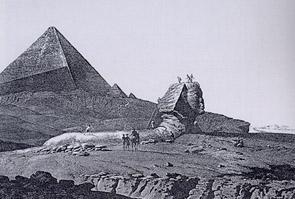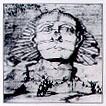|
Giza
Sphinx in Pictures
PAGE 1
|
The
earliest pictures of the Sphinx were produced by the ancient
Egyptians themselves during the New Kingdom, when the Sphinx
was already more than a thousand years old. Archaeological finds
at the site of the Sphinx, particularly those made by Selim
Hassan in the 1930s, include many stelae with depictions of
the monument, showing considerable variation as to the details
they record, or purport to record.
On some of the stelae, the Sphinx sits on a corniced pedestal,
on others there is no pedestal. Sometimes a crown tops the head
of the Sphinx: in some cases the combined Red and White Crowns
of Lower and Upper Egypt, in others a tall plumed crown. Sometimes
the beard is shown wedged like a king's beard, at other times
curled at the tip like a god's (as is the case with the actual
fragments of the beard). On some of the stelae, the Sphinx wears
the plumage of a bird, and a collar or cape.

The
Sphinx according to the "Description de l'Egypte"
at the end of the eighteenth century. |
On
most of the stelae, the proportions of the Sphinx are shown
more in accordance with the standard design of sphinxes after
the Great Sphinx, but it is interesting to note that the Dream
Stela itself depicts the proportions of head and body a little
closer to the real Sphinx than the rest; this stela of Tuthmosis
IV between the Sphinx's paws shows no crown on its two Sphinx
representations and the beard is of the divine pattern. But
on the Dream Stela, no statue is shown before the Sphinx's
breast, though many of the others do show it there. One of
the most interesting of these is that of the scribe Mentu-Hor
which uses unconventional artistic means, by the standards
of the ancient Egyptians, to suggest that the statue is between
the Sphinx's forelegs, by hiding the lower part of the statue's
legs behind the outstretched limb of the Sphinx.
In a similarly bold way, two pyramids are shown behind the
Sphinx, part-hidden by its body, and one part-obscuring the
other.

The
Sphinx according
to Pococke, 1743. |
|
 |

The
Sphinx according
to Norden, 1755. |
This
sort of perspective drawing is very unusual in Egyptian art
and suggests that on this occasion a more than usually naturalistic
effect was sought, which inspires confidence in the potential
accuracy of details like the presence of the statue and the
collar about the neck.
Some
two-and-a-half thousand years after Mentu-Hor, the German
traveller Johannes Helferich visited Giza and left us an account
of the Sphinx which, though containing fanciful material about
the ancient priests' getting inside the Sphinx's head to address
the multitude, does circumstantially suggest that he was reasonably
familiar with the site. The woodcut he had made for publication
in 1579 however, would suggest the opposite: this Sphinx is
blatantly female and the beast is shown buried in the sand
with, the hair resembling the damaged head-dress of the Great
Sphinx. We recall that Helferich thought the Sphinx was an
image of Isis.
The illustrator of George Sandys' "Relations of a Journey"
which began in 1610 made a much better job of depicting the
Sphinx. Sandys noted that 'Pliny gave it a belly' though only
its head was visible to him. He must have made a pretty detailed
sketch of it in the field, for the woodcut in his book is
remarkably apt at showing the erosion of the neck, with knobbly
protuberances, and the damage to the head-dress, with grooves
and notches. What is more, this illustration of Sandys' book
largely avoids the cultural contamination with the classical
style that spoils many of the renditions of Egyptian art made
before the end of the eighteenth century.
The picture of the Sphinx in Richard Pococke's account of
his Egyptian travels, published in 1743, does not altogether
escape the classical influence. Erosion and damage are fairly
accurately recorded, but the nose of the monument - gone for
several centuries by Rococke's time - is shown intact.
The Danish marine architect Frederick Norden published the
story of his travels in 1755, with a Sphinx drawing in more
recognizably ancient Egyptian spirit. The erosion of the face
and the damaged nose are recorded in Norden's picture and
something of the George Washington set of the head is captured,
with its slight Backward tilt. But the eyes, lips and chin
are still not right. With the magnificent Description de l'Egypte
that was published over a number of years in the early part
of the nineteenth century, the first really accurate depictions
of the Sphinx became available to world scholarship - in a
limited way - for the volumes were necessarily very expensive
and printed in small numbers.
Napoleon's team had done their work well and their efforts
in the field were well served by those who brought out the
volumes of the Description back to France after Napoleon's
downfall. The engravings of the Sphinx vividly portray the
damaged state of the face and head-dress and the erosion of
the neck as seen by Napoleon's engineers and servants.
|